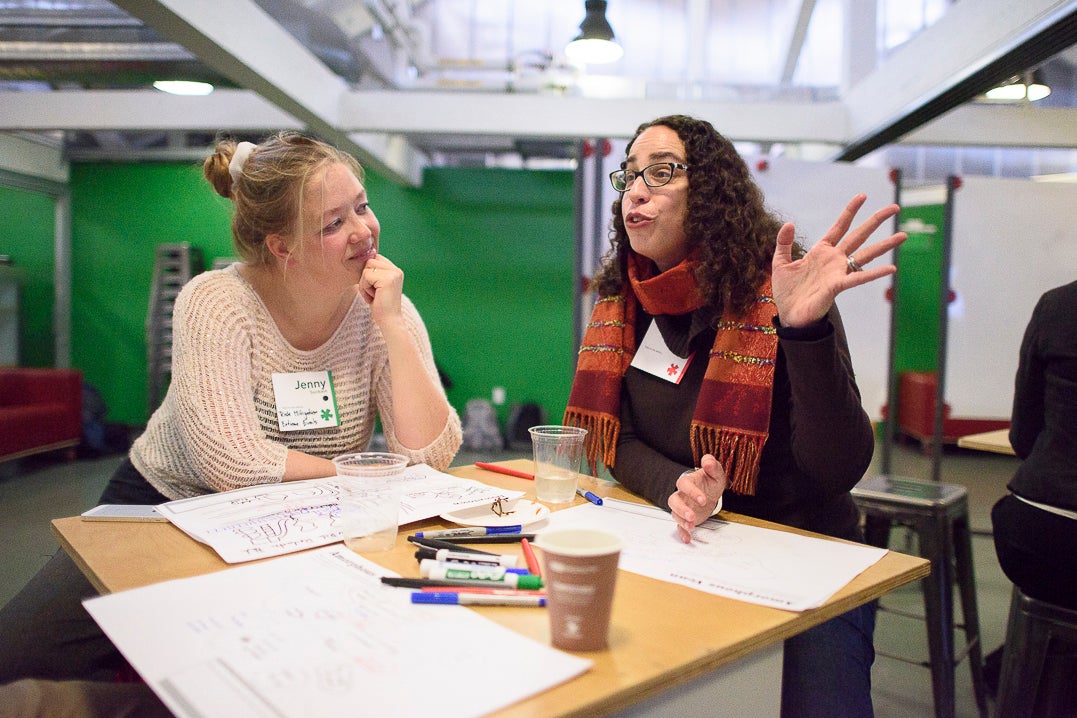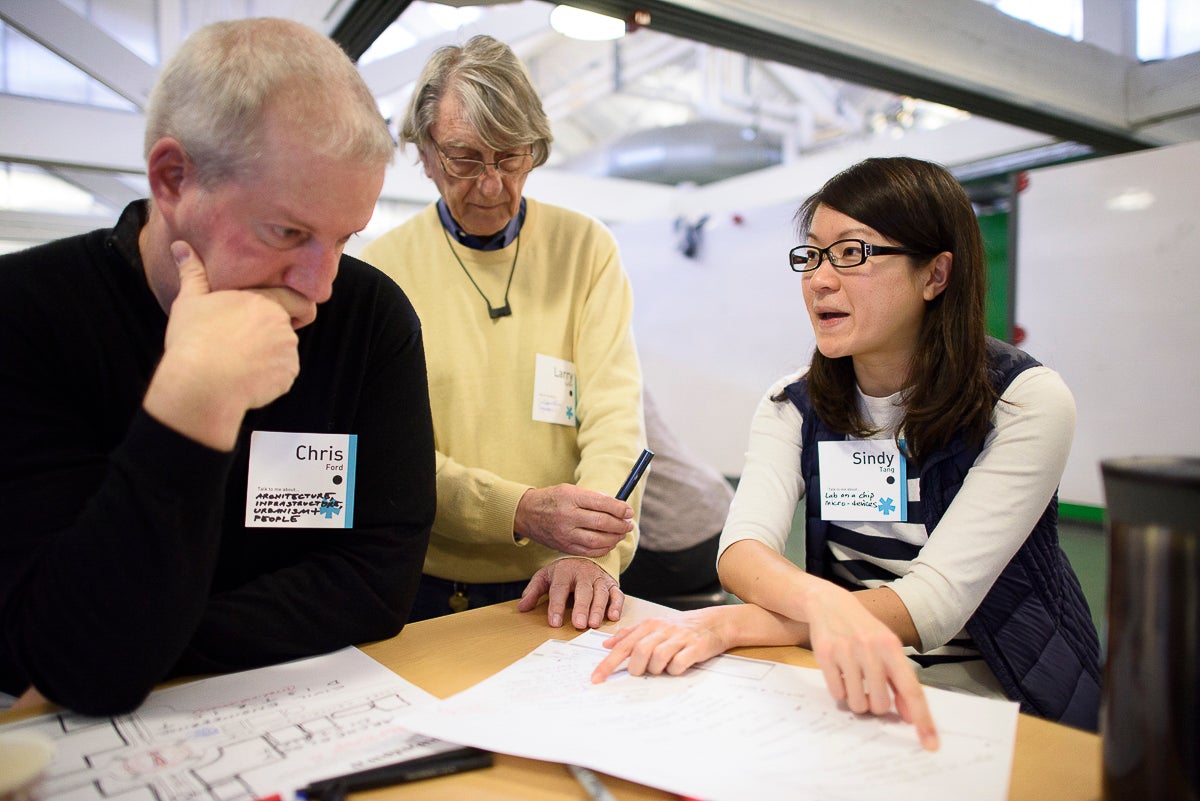Stanford Catalyst for Collaborative Solutions focuses on 10 global challenges
The Stanford Catalyst for Collaborative Solutions plans to award $12 million to four interdisciplinary teams, each committed to working in collaboration on projects that will make headway on one of 10 global challenges.
When Stanford Engineering conducted its school-wide strategic planning program two years ago, one of the main outcomes was the identification of 10 major global challenges on which it would like to have a significant impact.

Senior research engineer Jennifer Hicks, right, in discussion with Ilenia Battiato, assistant professor of energy resources engineering, at a workshop in the d.school designed to help faculty meet one another and start to identify common research interests as part of the Stanford Catalyst for Collaborative Solutions. (Image credit: L.A. Cicero)
But how? The issues highlighted were exceedingly complex, focusing on things like how to ensure humanity flourishes in the cities of the future and how to achieve effective yet affordable healthcare everywhere. Solving them would require not just ingenuity but the ability to bring together expertise from multiple disciplines and perspectives from Stanford, industry and the public sector.
To help achieve this audacious goal, the school has now launched the Stanford Catalyst for Collaborative Solutions. To start, the initiative will provide up to $12 million to four teams, each of them committed to working in collaboration on projects that will make significant headway on one of the 10 grand challenges.
This spring, Catalyst director John Dabiri and his team of advisors will identify and fund the first two projects, each receiving up to $3 million over three years, with two more teams to be identified for funding in early 2018.
Leveraging expertise
“This is an exciting opportunity to leverage Stanford’s expertise across all seven schools in collaborative pursuit of solutions to big challenges that are normally addressed piecemeal if at all,” said Dabiri, a professor of mechanical engineering and of civil and environmental engineering. “The Catalyst represents a bold investment by Stanford, and it has already proven to be a powerful convening force, bringing together faculty from nearly every discipline, most of whom are meeting for the first time.”
The proposals, due March 17, will be evaluated in part on teams’ willingness to take risks and explore ideas beyond the bounds of traditional research, according to Dabiri, and to an equal measure on their plan to “initiate and sustain meaningful interdisciplinary collaborations within the School of Engineering, across the university and beyond.”
Teams must include at least one member of the Stanford Engineering faculty as a member of the project leadership team. Beyond that, Dabiri said, teams should be composed of those best suited to working together to solve the problem rather than from any particular background. Teams are required in their proposals to address how every member of the team will interact with one another, and show how each individual is integral to the success of the project.

Jenny Suckale, assistant professor of geophysics, listens as law Professor Amalia Kessler shares during an exercise in the Catalyst seminar at the d.school. (Image credit: L.A. Cicero)
To kickstart the initiative, Dabiri and his team recently held a series of workshops during which several dozen faculty members from throughout the university participated in a series of collaborative exercises to help faculty from different schools and departments meet one another and start to identify common research interests.
“Communicating across disciplines is not always straightforward,” said d.school Executive Director Sarah Stein Greenberg, who led the workshops and serves on the Catalyst advisory board. “So we are engaging participants with a variety of tools to help foster unexpected connections and encourage new ideas to start to flow.”
In one warm-up exercise, Stein Greenberg asked participants to share in small groups how they’re known in their fields and how they’d like to be known. The goal, she said, was to help participants accelerate the normal rate of getting to know one another and to have a forum to explore their own aspirations and motivations and expose themselves to potential collaborators.
In another exercise, she asked participants to sketch out their disciplines to show the various intersections with other areas of expertise. In small-group discussions, participants explored how their individual disciplines combined, overlapped or stood apart from other fields. Participants began to see how the complex challenges of the world are most often solved in collaboration rather than in isolation.
“The workshop was a great opportunity to meet fascinating people from other schools and departments across the university whom I would never encounter through the normal course of my research and teaching, given how specialized we all tend to be,” said law Professor Amalia Kessler.
Meaningful collaboration, bold risks
At the workshops, organizers asked participants to consider in small groups and bring their own expertise to bear on the issue of how humanity can flourish in the cities of the future. “It was very interesting to see that despite our disciplinary differences,” Kessler said, “colleagues specializing in civil engineering and risk management and I ended up agreeing that a core hindrance to meaningful change of any kind is deep-rooted, institutionalized forms of structural inequality.”

Doctoral candidate Chris Ford, Professor Larry Leifer and Assistant Professor Sindy Tang, all of the Department of Mechanical Engineering, work on one of the exercises in the Catalyst workshop. (Image credit: L.A. Cicero)
Economist Garth Saloner, former dean of the Graduate School of Business, said that one important feature of the Catalyst initiative is that it will provide workshops, forums, conferences and dinners to facilitate the formation of cross-disciplinary teams that don’t already exist.
“Many of the societal challenges that social scientists are interested in require a deep understanding of technology or have solutions that are in part implemented through technology. Enabling faculty in different schools who have different pieces of the puzzle to find one another will be a unique and core feature of the Catalyst model,” said Saloner, who serves on the Catalyst advisory board.
Dabiri notes that the outcome of the projects will vary depending on the team. For some it may include development of a new technology; for others it may be the implementation of a policy mechanism. The key, he said, is that by providing funding that explicitly requires meaningful collaboration and encourages the kinds of bold risks that do not normally get funded, the Catalyst can be a model for high-impact and interdisciplinary research.
An equally important outcome, he said, is that it will create a new network of faculty, staff and students working collaboratively to solve the world’s most urgent challenges.
“Our primary goal at this stage is to encourage participation from all parts of the Stanford community through the program funding and other activities to come,” he said.
